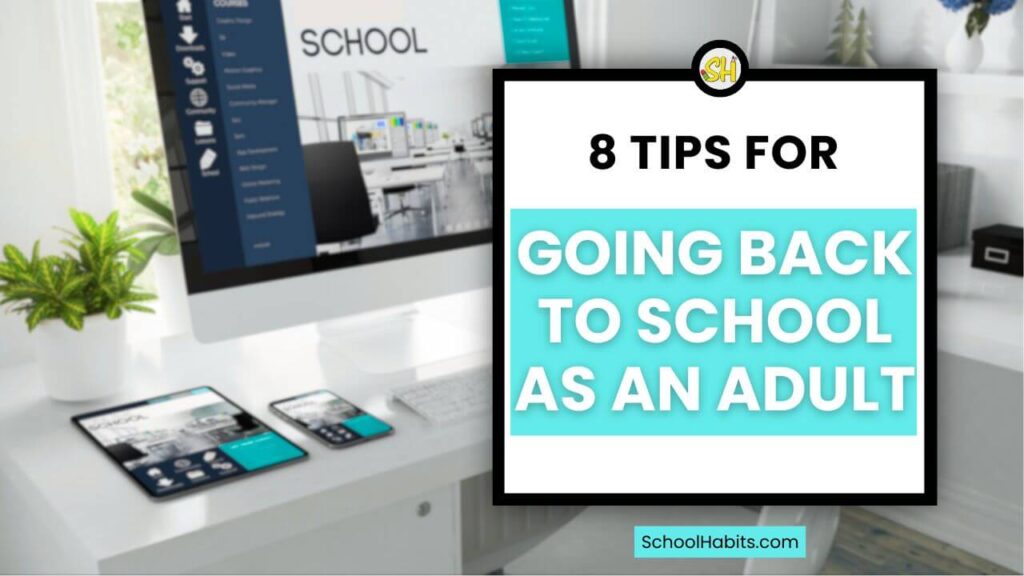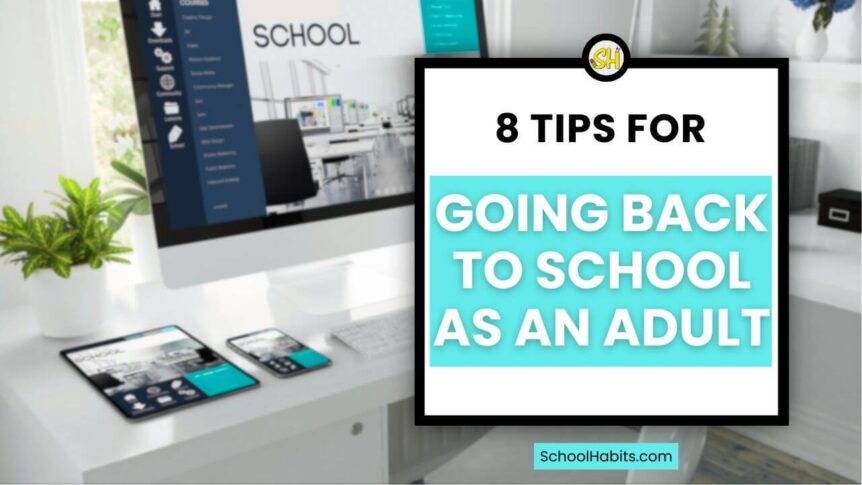
By Katie Azevedo, M.Ed.
Going back to school as an adult can be an incredible experience that leads to career and personal growth (and usually, a salary boost). But, going back to school as an adult requires adequate preparation and new strategies.
Maybe you’re pursuing an advanced degree to further your career, enrolling in an undergraduate program thirty years after high school, or simply taking adult education classes for personal enrichment.
Regardless of why you’re headed back to school, the following strategies will help you stay balanced, reduce your stress, and succeed in a classroom when you haven’t stepped foot in one for years.
3 Tips for BEFORE Going Back to School As an Adult
You’ve made the commitment to return to school. That’s incredible. The following 3 tips can increase your chances of succeeding in your program. (Also, consider reading my tutorial titled Should You Go to Grad School?)
1. Choose the Right Program
Going back to school as an adult usually means adding a major commitment on top of an already full life. That’s why choosing the right type of program, not just the subject or degree, is critical.
Consider your current lifestyle and whether an in-person, online, or hybrid model fits best with your schedule. If you’re balancing a job or family, an asynchronous online program might offer the flexibility you need.
On the other hand, if you need real-time interaction and accountability, in-person or live virtual classes may be a better choice.
It’s also worth asking whether the program offers evening or weekend options, and how often you’re expected to be physically on campus. When you’re thoughtful and strategic about choosing your program from the beginning, you’ll reduce the feeling of being burned out and regretful.
2. Start Slow
It’s easy to overcommit to a program, especially if you’re excited about it. But my advice to adult learners going back to school is to start slow.
Unless you need to enroll full-time, many adult learners are more successful when they take on a part-time student schedule. You can always start by taking one or two classes at a time and then assessing how well you handle that workload.
Remember, when you’re an adult learner, you’re much more than a student: you’re balancing work and family obligations that can make even one to two classes feel difficult.
3. Use All Three Semesters
Most people think undergraduate and graduate programs are only two semesters (fall and spring). But that’s not true.
The majority of undergraduate and graduate programs offer courses over the summer. There are usually Summer Session I and Summer Session II offerings..
Taking courses during one or both summer sessions can be a lifesaver for adult students who are unable to take a full course load during the traditional fall and spring semesters.
The benefit of summer sessions is that they usually meet on a more concentrated schedule. For example, you could take a course in two weeks over the summer that would otherwise take four months during the fall semester.
Granted, these concentrated courses move quicker and you need to be prepared to do just as much work in a short amount of time, but for some people, that is an excellent way to work toward a degree or certificate. Here are my best tips for taking summer intensive courses.
Personally, when I got my master’s degree in special education, I took as many summer courses as were allowed. This made it possible to earn my degree quickly, while not burning out with a full course load during the school year (which is when I was also a high school teacher).
5 More Tips for Going Back to School As an Adult
Once you’ve researched and committed to a program that will work with the stage of life you’re in (tips #1-3), you can implement some strategies to increase your chances of success (tips #4-8). You’ll find those below.
4. Understand the Required Technology
Depending on when you were last in a classroom, things have likely changed a lot, especially when it comes to technology. Today’s schools rely heavily on digital tools, and being able to navigate them is no longer optional. In fact, it’s necessary.
At a minimum, you’ll need to know how to access and use your school’s student portal, which is where professors post assignments, grades, announcements, and course materials.
Most instructors expect students to not only receive assignments through their student portals but also to submit them through this same system. That means you’ll need to be comfortable uploading documents, downloading files, contributing to discussion boards, and communicating through school-based internal messaging systems.
You’ll also need to get familiar with common digital workflows like downloading PDFs, filling out forms electronically, and annotating documents with tools like Notability, Adobe, or built-in features on your device. Whether or not you’re naturally “tech-savvy” is irrelevant; these are now basic literacy skills in the academic world.
The good news is that many schools offer tech orientations, help desks, or even mini-trainings to get you up to speed. You’ll be just fine if you take advantage of these resources early on. The sooner you become comfortable with the logistics of learning, the sooner (and more) you’ll be able to learn.
5. Create a Task Management System
Going back to school as an adult requires ninja-level task management. If you’re a working professional or managing a household, you likely already have some kind of system to track those aspects of your life. However, when you add school assignments to the mix, you need to up-level how you manage all the moving parts.
In the previous tip, I talked about the importance of understanding technology, especially the student portal. I explained that the student portal is where professors post assignments.
But let me be clear: the student portal is not a task management system. Your portal is where you access and submit assignments, but it is not where you manage them.
This is one area where I get a lot of pushback until I explain it this way: Your professors are the only ones who can add information to your portal. But as with any task management system, you need to add your own tasks.
An example: If you’re assigned an essay that’s due next week, you need a place to track the different parts of that essay and when you’re going to work on them.
Another example: If you have an exam in two weeks, you need a place to track what and when you’ll study.
You are unable to add these tasks to your student portal, which is why your student portal is not an adequate task management system.
Some adult learners with already well-working task management systems simply add school assignments to what they’re currently using. This is fine. This is actually my recommendation for most people.
For example, if you’re currently using an analog notebook to track work and life tasks, simply add your academic tasks to your notebook.
However, you can also keep your work and academic tasks separate. That’s something you’ll have to experiment with and figure out for yourself.
Below is one of my top resources for creating a task management system. It’s an episode from my Learn and Work Smarter podcast.
6. Don’t Multitask.
Multitasking is a myth. When we try to do it, we sacrifice performance all around. Instead, keep work and school separate, and avoid going back and forth between contexts without a clear separation point.
Let me give you an example of well-meaning multitasking that actually makes things worse:
Imagine you’re at your desk, waiting for a Zoom meeting to start. You decide to do one of your academic readings until the host begins the meeting. Because part of your attention is waiting for the meeting to start, you’re not giving your full attention to the reading. And because part of your attention is on the reading, you’re not noticing what’s happening on the screen. Therefore, the two minutes of multitasking before the meeting starts is a waste of time.
Pro Tip: Try background tasking instead.
So what do we do instead? There are a couple of ways to go about this:
- Designate specific days for schoolwork, such as Tuesdays and Thursdays.
- Dedicate a specific time each day to school work (like 8:30-10:30 at night).
- Work on light school assignments during your lunch break. This is my least favorite approach because getting up from your desk for a break in the middle of the day can lead to greater productivity overall.
7. Take Advantage of Pockets of Time Throughout the Day
This strategy may seem contradictory to the one before it. But taking advantage of pockets of time in your day to work on assignments or readings is not the same as multitasking.
Let’s say you have a 40-minute train ride to work. This commute is the perfect time to listen to an online lecture or complete a reading.
Or let’s say a work meeting was canceled last minute, and you don’t have any pressing professional tasks to fill that space; that would be a great time to slip in a school assignment.
In other words, this strategy is more about using both predictable (your commute) and surprise (canceled meetings) time pockets throughout your day to make progress on assignments.
Now, the key to this strategy working well is to have ready access to your assignments in case these time pockets open up. For example, you can only read your book on the train if you bring your book with you. You can only listen to 20 minutes of an online lecture class during canceled-meeting time if you have headphones with you.
So at a bare minimum, keep a device, a notebook, and a set of headphones with you at all times, if possible.
Related Resource: How to Manage Time in College: 4 Strategies (these are super relevant to adult students)
8. Use All Your School’s Resources
Your school has an abundance of resources that can make going back to school as an adult easier. Some common resources available to students are:
- Professor office hours
- TA office hours
- The writing center
- Career training
- IT support
- Library tech support (for help accessing and using your school’s database and research tools)
These resources are also available if you’re taking online courses. Using even just one of the supports above can remove a barrier to your academic experience.
Final Notes About Going Back to School as an Adult
Going back to school as an adult is a big deal. It’s also not easy. But with the right systems and strategies, it’s doable.
You don’t need to be the most tech-savvy person or have unlimited free time to succeed as an adult student; you just need a plan that works for your version of life.
Start with intention. Pace yourself. Use what’s available to you. And most importantly, trust that you’re capable of learning new things…because you are.
This chapter of your life might look different than it did when you were 17, but that’s a good thing. You’re wiser now. You’re more focused. And with a few smart moves, you can do this.
PS: As a bonus strategy, consider implementing this monthly reset routine.

